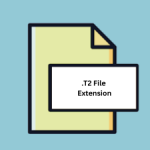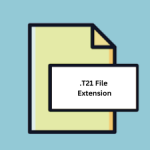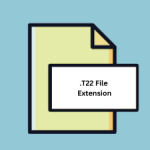.TLINE File Extension

TimelineOnline Data File
| Developer | zSnout |
| Popularity | |
| Category | Data Files |
| Format | .TLINE |
| Cross Platform | Update Soon |
What is an TLINE file?
.TLINE files, denoted by the file extension “.TLINE,” are data files primarily associated with TimelineOnline, a platform tailored for creating, editing, and sharing timelines.
These files encapsulate chronological information, enabling users to organize events, milestones, and historical data in a structured format.
More Information.
The inception of .TLINE files align with the emergence of TimelineOnline, which sought to streamline the process of timeline creation and collaboration.
Originally conceived as a web-based application, TimelineOnline aimed to empower users with a versatile platform for organizing chronological data intuitively.
.TLINE files were designed as the native file format for storing and exchanging timeline information within the TimelineOnline ecosystem.
Origin Of This File.
The genesis of .TLINE files can be traced back to the development of TimelineOnline, a web-based application aimed at simplifying the creation and management of timelines.
TimelineOnline was conceptualized to address the need for a user-friendly tool capable of visually representing temporal data across various contexts, including historical events, project timelines, and personal milestones.
File Structure Technical Specification.
.TLINE files adhere to a specific structure optimized for storing chronological data in a structured manner. While the exact technical specifications may vary based on the version of TimelineOnline and the features incorporated, a typical .TLINE file comprises metadata and event entries arranged chronologically.
The metadata section may include information such as the title of the timeline, descriptions, and any additional attributes deemed relevant.
Each event entry within the .TLINE file typically consists of details such as the event title, date or time range, description, and optional media attachments such as images or links.
.TLINE files may utilize formats such as JSON (JavaScript Object Notation) or XML (eXtensible Markup Language) to represent the hierarchical structure of timeline data. This enables interoperability and ease of parsing for both human users and software applications.
How to Convert the File?
Converting .TLINE files to other formats or platforms may be necessary to overcome compatibility constraints or leverage additional features. Below are general methods for converting .TLINE files across different operating systems:
1. Online Converters:
- Utilize online file conversion services that support .TLINE files. These platforms often offer a straightforward interface for uploading your .TLINE file and selecting the desired output format.
- Such as CSV (Comma-Separated Values) or PDF. Some popular online converters include Zamzar, Online Convert, and Convertio.
2. TimelineOnline Export:
- If using TimelineOnline, access the platform via a web browser and log in to your account.
- Navigate to the timeline containing the .TLINE file you wish to convert.
- Look for an export or download option within the TimelineOnline interface. This may allow you to export the timeline data in alternative formats, such as CSV, PDF, or image files.
- Follow the prompts to select the desired format and initiate the export process. Once completed, you can download the converted file to your device.
3. Dedicated Software:
- Explore dedicated timeline or data management software that supports the import and conversion of .TLINE files. Look for applications specifically designed for creating and visualizing timelines, as they may offer robust conversion capabilities.
- Install the software on your computer and follow the instructions provided to import the .TLINE file. Once imported, you should have the option to export or save the timeline data in various formats compatible with the software.
4. Third-Party Plugins or Extensions:
- Check if there are any third-party plugins or extensions available for popular software applications that support .TLINE file conversion. These plugins/extensions may extend the functionality of existing software to include support for importing and exporting .TLINE files.
- Install the relevant plugin or extension according to the instructions provided, and use it to convert .TLINE files to your desired format within the host application.
5. Command-Line Tools (for Advanced Users):
- Advanced users familiar with command-line interfaces may opt to use command-line tools or scripts to convert .TLINE files. Depending on the platform, there may be command-line utilities capable of parsing and manipulating .TLINE files directly.
- Research command-line options compatible with your operating system and follow the documentation or guides provided to execute the conversion process using the command-line interface.
Advantages And Disadvantages.
Advantage:
- Structured Organization: .TLINE files facilitate the systematic organization of chronological data, allowing users to create coherent timelines with ease.
- Interoperability: Due to their standardized format, .TLINE files can be seamlessly exchanged and accessed across different platforms and applications.
- Visual Representation: TimelineOnline and .TLINE files enable users to visualize temporal data in a visually appealing and comprehensible format, enhancing understanding and analysis.
Disadvantage:
- Platform Dependency: .TLINE files are closely tied to the TimelineOnline platform, which may limit their usability outside of this ecosystem.
- Limited Features: While .TLINE files excel at representing chronological data, but they may lack advanced features found in dedicated timeline software or formats.
- Compatibility Issues: Users may encounter compatibility issues when attempting to open or convert .TLINE files using incompatible software or outdated versions.
How to Open TLINE?
Open In Windows
TimelineOnline Website: Visit the TimelineOnline website using any web browser on your Windows computer. Log in to your account and access the .TLINE file. You can view and edit the timeline directly in your browser.
Open In Linux
TimelineOnline Website: Similar to Windows, you can use any web browser on your Linux system to visit the TimelineOnline website. Log in to your account and access the .TLINE file to view and edit your timeline.
Open In MAC
TimelineOnline Website: Just like on Windows and Linux, you can access the TimelineOnline website via any web browser on your macOS device. Log in to your account, and you’ll be able to view and edit your .TLINE files online.
Open In Android
TimelineOnline Mobile App: Install the TimelineOnline mobile app from the Google Play Store on your Android device. Once installed, log in to your account within the app. You’ll be able to access your .TLINE files and work on your timelines directly from your Android device.
Open In IOS
TimelineOnline Mobile App: Go to the App Store on your iOS device and download the TimelineOnline mobile app. After installation, log in to your account within the app. You’ll then be able to access and edit your .TLINE files on your iPhone or iPad.
Open in Others
- Third-Party Software: While .TLINE files are primarily associated with TimelineOnline, you may explore third-party software or applications compatible with your platform that support importing or converting .TLINE files. Look for timeline management or data visualization software that offers cross-platform compatibility.
- Online File Converters: If you need to convert .TLINE files to a different format, you can use online file conversion services accessible from any platform with an internet connection. Upload your .TLINE file to the converter and select the desired output format. Once the conversion is complete, download the converted file to your device.













